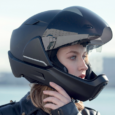Any kind of protective motorcycle gear is important. But since the helmet protects one of our most vulnerable organs, our brain, we should be extra careful when picking out a good motorcycle helmet. Learn here, which helmets have proven themselves to be effective in the past, and where modern technology is leading to.

Effective Motorcycle Helmets
Motorcycle helmets have scientifically proven to be effective at saving lives, reducing the severity of head injuries received during motorcycle crashes, and shortening the time it takes to recover in and outside of the hospital. Since we are less likely to walk away from a heavy impact to the brain and neck in comparison to other body-parts, we should take extra care in protecting our head. There are several factors we can look at to find effective motorcycle helmets.
The Different Kinds of Motorcycle Helmet
When you look at the helmets from ChromeBurner.com, a specialized vendor for motorcycle gear, you can see that there are many different shapes of helmets. For a very basic breakdown, you can divide them into three classes:
- Open-Face Helmets: This includes any helmet that does not have a chin bar to protect the entire head, like a ¾- or jet helmet. They are often lighter and allow the wearer to breathe more easily, while restricting less of the movement and field of vision.
- Modular Helmets: This helmets are a mix between open-face helmets and full-face helmets. They have a chin bar, but it can be flipped up for more versatility.
- Full-Face Helmets: Full-face helmets cover the entire head, including a chin bar and often a built-in visor.
Among these, especially the full-face and modular helmet types, there are helmets with different builds and uses. For example, helmets for off-road racing are usually lighter, shaped more aerodynamic and have peaks over the visor to protect from the sun.
What to Look Out for When Buying a Motorcycle Helmet?
There are some tips that will help you find the most efficient helmets:
- Always buy a full-face or modular helmet. An open-face helmet offers no protection for your chin, nose, and eyes. Plus, the enclosed shape of the full-face helmet is better at catching and redistributing the impact force in a crash, since it has more surface to redirect the force to. The full-face helmets have also been tested to not impede the vision of a person, the way many anti-full-face-helmet riders claim.
- Always buy a certified helmet. Some government authorities or motorcycle foundations do quality and safety testing for motorcycle gear. Here, they examine the quality and efficiency of a helmet. It gets tested and subjected to multiple weather conditions and various impacts. Only the helmets that manage to reduce the force that reaches the wearer’s head sufficiently to protect their health will get certified. Important certificates are the FIM, DOT, SNELL, ECE or SHARP standards.
- Always buy new helmets from official vendors. A helmet that has been subjected to an impact – whether it’s a fall or a crash – can lose its efficiency, even if the resulting hairline fissures and weaknesses are not visible. Additionally, the protective foam lining in a motorcycle helmet will degenerate after 5 years. That’s why you should replace motorcycle helmets often, at least every 5 years or after every impact.
New Developments for Motorcycle Helmets
These motorcycle helmets with certificates from the different testing agencies have been proven to be efficient. But naturally, the development of new technologies and materials never rests. For motorcycle helmets, the research focuses on strong but light materials and the implementation of technology and AI use.
In recent years, multiple companies have started working on helmets with AI (artificial intelligence) and AR (augmented reality) technology. These helmets use sensors, cameras, processors, and algorithms to analyze what is happening and give the rider helpful feedback.
Especially ambitious projects are looking to display navigational information and other data directly onto the rider’s visor. However, since the testing authorities still have doubts about the road safety and possible distraction due to the head up display, these helmets are still in testing and won’t reach mass production anytime soon.
There are, however, already separate HUD systems you can buy to attach to the helmet yourself. These gadgets add a small screen on top of the chin guard which displays the navigational information in a small scale in the corner of the rider’s eye.
Conclusion
Motorcycle helmets are an important piece of protective motorcycle gear. They protect your head, neck, and reduce the severity of impact force effecting your brain. They have proven time and time again to keep riders out of the hospital or keep an accident from turning fatal. To buy effective helmets, there are some things to keep in mind.
Buy new helmets, replace them regularly, buy full-face helmets, and make sure the helmet you buy is certified. If they succeed in testing, some time soon helmets with AI and AR technology might be available.




